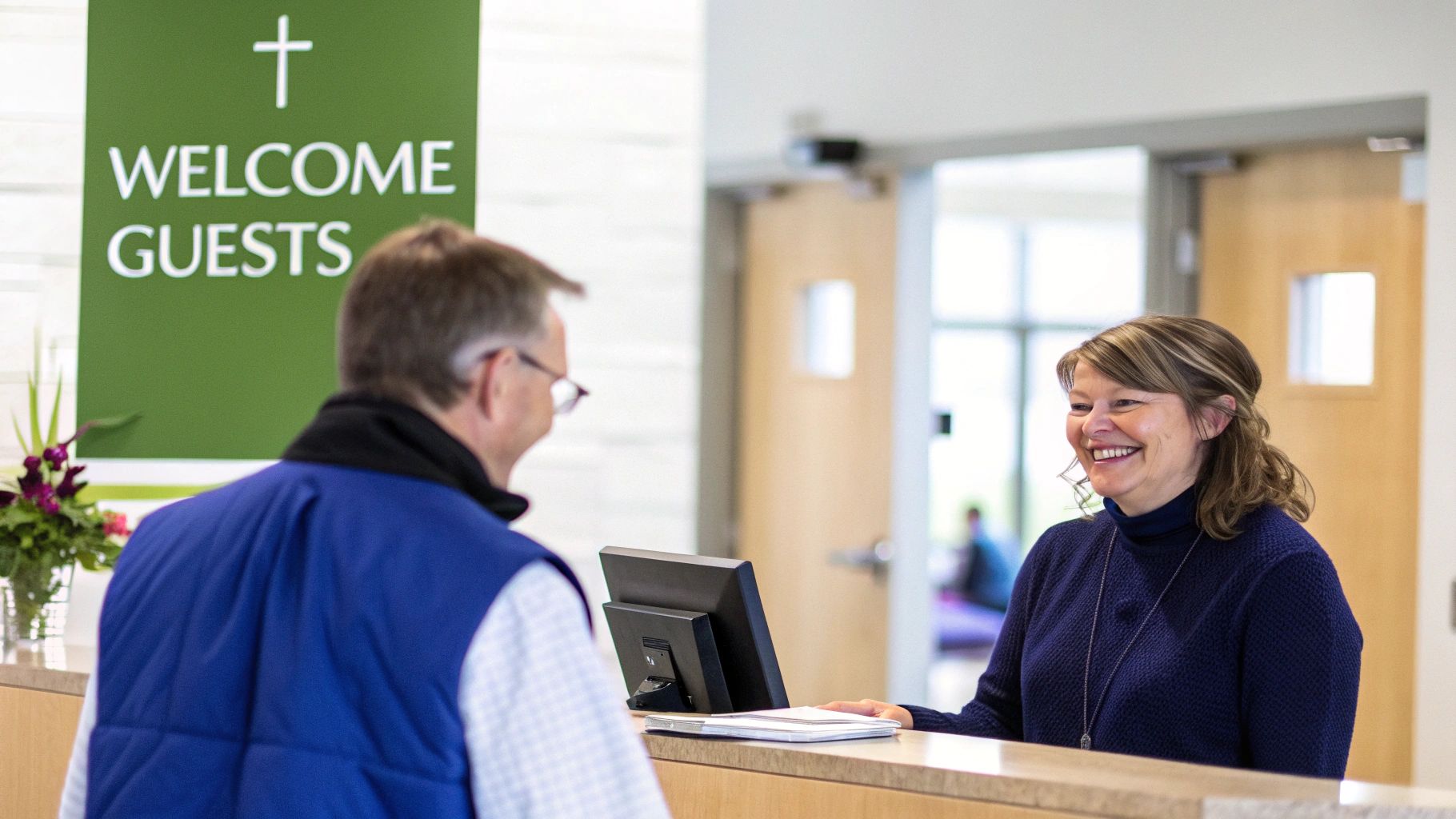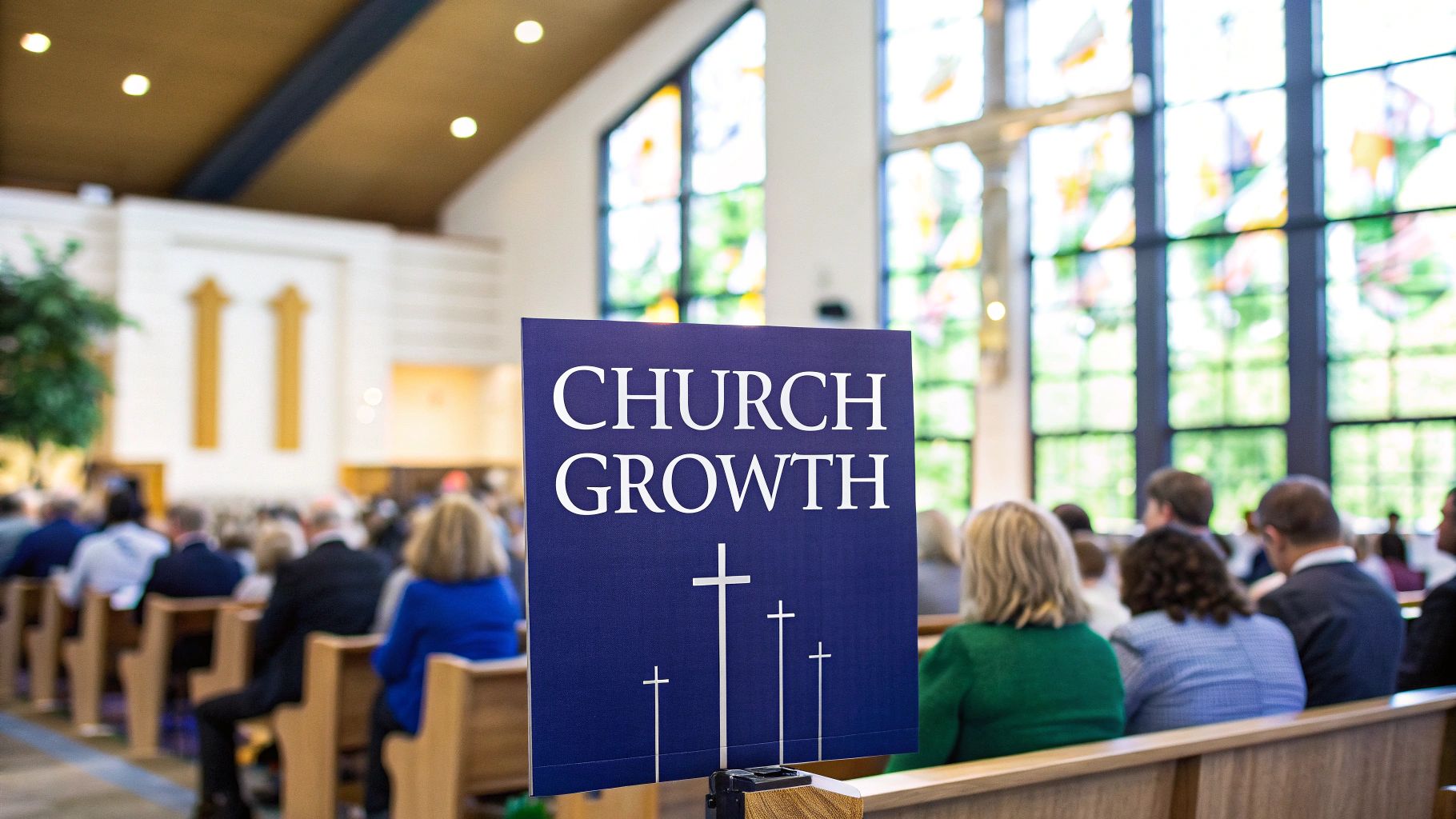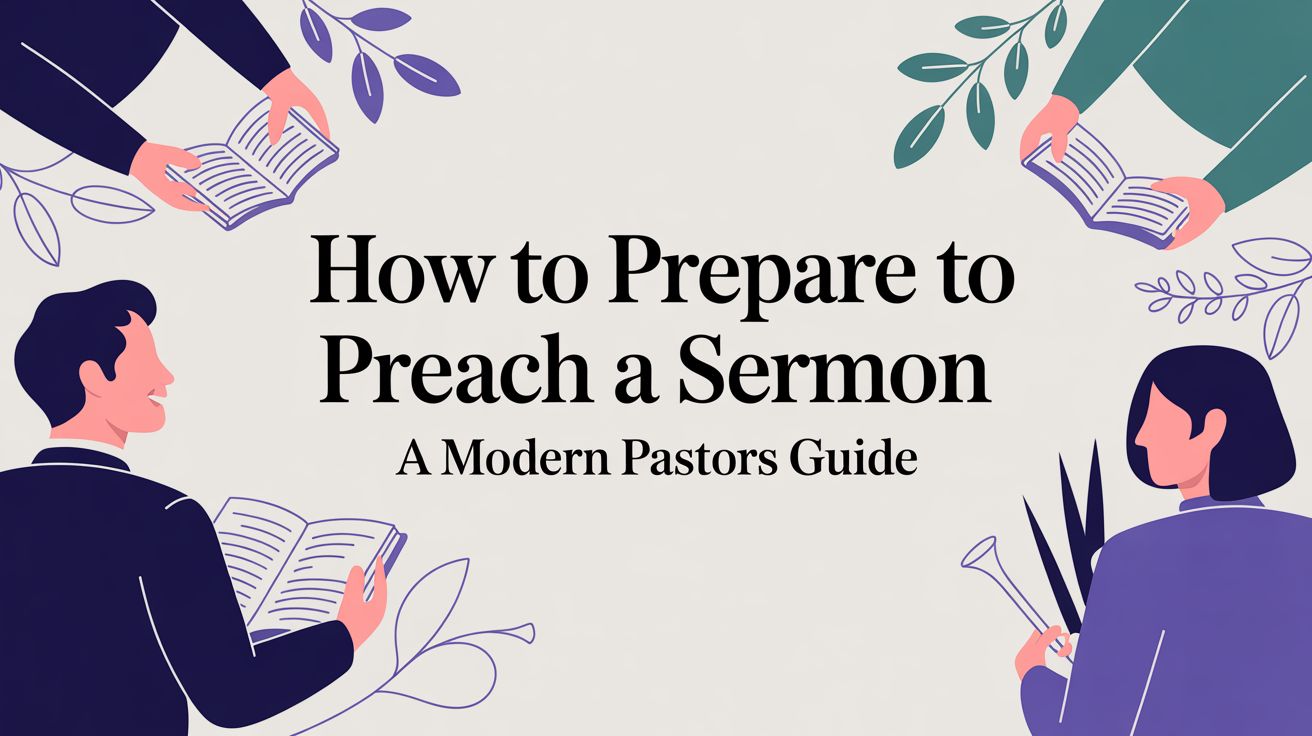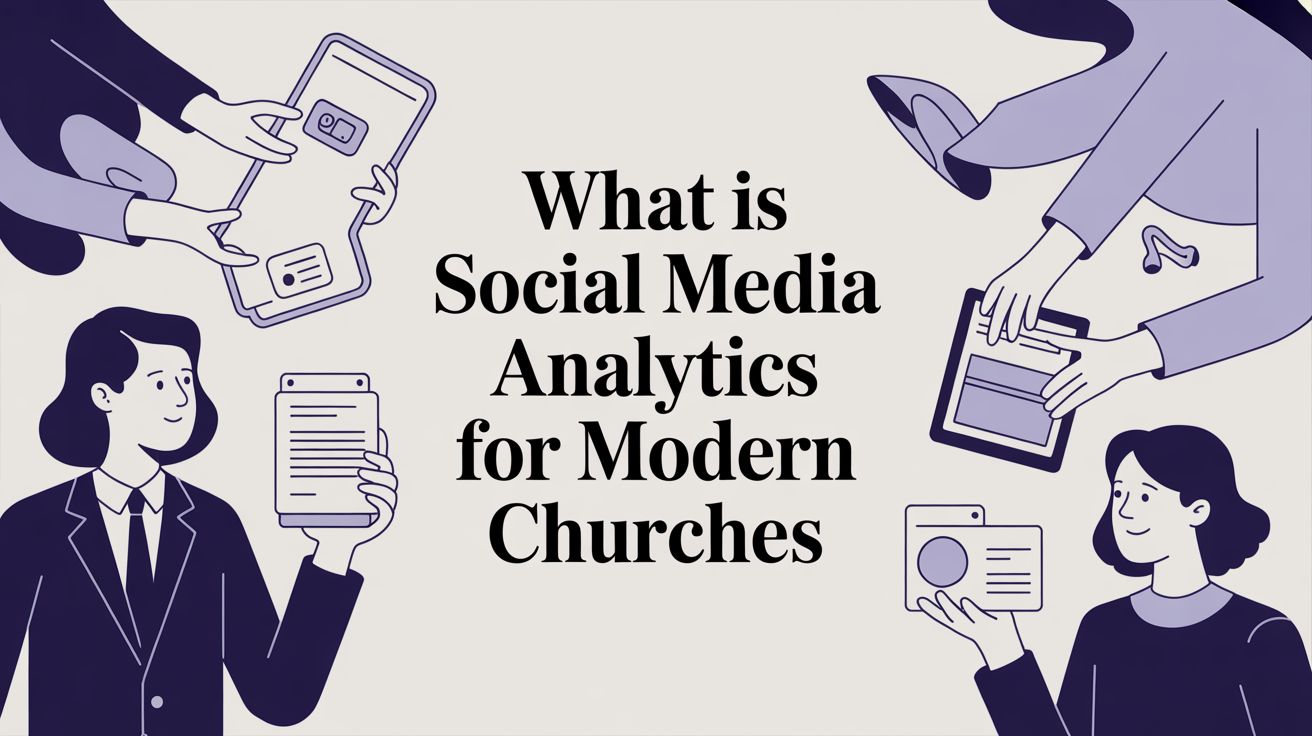In a rapidly changing world, connecting with your community and fostering a thriving congregation requires more than just opening the doors on Sunday. It demands intentionality, vision, and a willingness to adapt. This guide explores 10 proven church growth strategies that address every facet of modern ministry, from creating an unforgettable first-time guest experience to leveraging the power of digital outreach. We'll move beyond theory and provide actionable steps, practical examples, and fresh perspectives to help you build a healthy, growing church that makes a lasting impact.
As we delve into these strategies, a recurring theme will emerge: the critical role of digital communication. Platforms like social media are no longer optional but essential for connecting with current members and reaching new ones. Throughout this article, we will highlight how a dedicated tool can streamline these efforts. With ChurchSocial.ai, you can automatically generate reels and social posts from sermon transcripts, design graphics with easy templates and an intuitive editor, and manage your entire content calendar with a simple drag-and-drop interface. It even integrates with Planning Center and other church calendars to create event content, allowing you to focus more on ministry and less on management.
Of course, true sustainable growth depends on a solid foundation, which includes everything from a clear discipleship pathway to sound financial stewardship. For sustainable growth, sound financial management is key, which often includes utilizing appropriate accounting software for small churches. By integrating robust systems for both your outreach and your operations, you prepare your ministry for health and expansion. Let’s dive into the specific strategies that can unlock your church's full potential.
1. Master Digital Ministry and Online Engagement
In today's connected world, one of the most vital church growth strategies is mastering your digital ministry. A church's online presence often serves as its "front door," providing the first impression for potential visitors and a crucial connection point for current members. This extends far beyond simply streaming Sunday services; it involves creating an integrated digital ecosystem where your community can engage, grow, and connect throughout the week. A robust digital strategy ensures your ministry is accessible anytime, anywhere, meeting people exactly where they are.
Building a Thriving Online Community
The goal is to transform passive online viewers into active community participants. This requires a multi-faceted approach that fosters interaction and provides genuine value outside of weekend services.
- Interactive Livestreams: Enhance your online services with a dedicated host who can welcome viewers, moderate comments, and guide them to next steps like virtual prayer rooms or online giving.
- Digital Discipleship: Create online-exclusive content such as video devotionals, podcast series, or virtual small groups that meet via video conferencing. These platforms offer flexible ways for people to deepen their faith on their own schedule.
- Seamless Social Media: Your social media channels are powerful tools for community building. Instead of just making announcements, ask questions, share prayer requests, and celebrate member stories. To create an interactive and visually dynamic experience during services or events, churches can display a live feed of congregation posts and comments using tools like social media walls.
Actionable Steps for Implementation
To streamline your digital ministry, you need a tool designed to handle the unique content needs of a church. ChurchSocial.ai is built specifically for this purpose. It helps you repurpose sermon content into AI-generated reels, blog posts, and social graphics, saving your team valuable time. Its simple drag-and-drop calendar allows you to easily manage and update all of your social media accounts in one place. By integrating with church calendars like Planning Center, it can also create content for your events automatically. This level of automation empowers your team to focus on building authentic relationships online, turning your digital presence into a vibrant community hub.
2. Multisite and Multi-Campus Strategy
A powerful engine for expansion, the multisite model is one of the most transformative church growth strategies of the modern era. This approach involves launching additional physical locations, or campuses, that share the same vision, leadership, and resources as the original church. Instead of building one massive central auditorium, the church takes its unique ministry DNA to new neighborhoods, cities, or even states. This allows a church to reach geographically diverse communities without losing the core identity and culture that made it successful in the first place.
Scaling Your Impact and Leadership
Successfully implementing a multisite strategy requires more than just finding a new building; it’s about reproducing your church's culture and systems effectively. The goal is to create a unified experience across all locations, ensuring that someone attending a campus 50 miles away feels just as connected as someone at the original venue.
- Centralized Vision, Localized Expression: While core teaching and vision come from a central leadership team, often delivered via high-quality video, each campus needs empowered local leadership. A campus pastor is crucial for providing on-site pastoral care, leading local outreach, and building a distinct community feel.
- Systematize for Scalability: Create replicable systems for everything from kids' ministry check-in and volunteer onboarding to guest follow-up. This operational consistency ensures a smooth and high-quality experience at every location, which is foundational for sustainable growth.
- Maintain Cultural Unity: Clear and constant communication is the glue that holds a multisite church together. Regular leadership meetings, shared training resources, and all-staff events help reinforce a single, unified culture across geographically separate teams.
Actionable Steps for Implementation
A multisite strategy magnifies the need for streamlined communication. Managing social media for multiple campuses can quickly become overwhelming. This is where a centralized platform becomes essential. With ChurchSocial.ai, you can manage social media for every campus from a single dashboard. Create sermon-based content like AI-generated reels and social posts, then use the simple drag-and-drop calendar to schedule them for specific campus pages. By integrating with church calendars like Planning Center, it can automatically generate and post promotional content for events at each location, ensuring every campus community stays informed and engaged without adding extra work for your campus pastors.
3. Assimilation and Connection Systems
One of the most impactful church growth strategies involves moving beyond a simple "welcome" and implementing a systematic process for assimilation. This strategy focuses on intentionally guiding a first-time guest from being an anonymous attendee to becoming a fully engaged and connected member of the church family. It’s about creating a clear and simple pathway that removes guesswork for newcomers and ensures no one falls through the cracks. A well-designed assimilation system acts as a relational bridge, demonstrating that you not only see your visitors but have a specific plan to help them belong.
Building a Clear Path to Belonging
The goal is to create an obvious and frictionless journey for guests. This requires a coordinated effort, from the parking lot to their first small group, making each step feel natural and inviting. Churches like Saddleback, with their renowned "CLASS 101" membership course, have shown how a structured pathway can effectively integrate thousands into the life of the church.
- First Impressions Matter: The assimilation process begins the moment a guest arrives. Train your welcome team to be proactive, friendly, and helpful, creating an exceptional first experience that makes visitors feel genuinely valued.
- Strategic Follow-Up: Implement a system to follow up with every first-time visitor within 24-48 hours. A simple text message, email, or a personal call can make a profound impact and opens the door for further connection.
- Multiple On-Ramps: Recognize that people connect in different ways. Offer a variety of low-barrier entry points for involvement, such as a newcomer's lunch, a short-term volunteer opportunity, or an online "get to know us" session.
Actionable Steps for Implementation
To make your assimilation process efficient, you need tools that can manage and promote your connection events. ChurchSocial.ai can help automate parts of this journey. Its simple drag-and-drop calendar integrates with your church management system to schedule and promote upcoming connection events like membership classes or small group sign-ups. You can use the graphic templates and editor to create a series of social posts or carousels highlighting these next steps, consistently communicating the pathway to belonging. This automation frees up your team to focus on personal interactions, ensuring that your systems support, rather than replace, genuine relationship-building.
4. Discipleship and Leadership Pipeline Development
A truly sustainable church growth strategy focuses on internal development just as much as external outreach. Creating a robust discipleship and leadership pipeline is the engine that powers long-term health and expansion. This is a deliberate process of identifying, training, and empowering individuals at every stage of their spiritual journey, moving them from passive attendees to engaged members, dedicated volunteers, and eventually, capable ministry leaders. As popularized by leadership experts like Andy Stanley and John Maxwell, this model ensures your church is never limited by a lack of qualified, passionate people to lead new initiatives.
Building a Culture of Empowerment
The goal is to cultivate an environment where leadership development is a natural and expected part of the church experience, not a program reserved for a select few. This requires a systematic approach to nurturing talent and providing clear pathways for growth, similar to the leadership pipelines seen in organizations like North Point Community Church.
- Intentional Identification: Actively and consistently look for potential in your congregation. This goes beyond observing who is most charismatic; it involves identifying individuals who demonstrate faithfulness, teachability, and a heart for service in any capacity.
- Structured Pathways: Develop clear, tiered opportunities for growth. This could start with a "new members" class, progress to a volunteer training program, and culminate in an apprenticeship-style leadership cohort or mentorship program.
- Hands-On Experience: True leadership is forged through practice. Provide safe, supervised opportunities for emerging leaders to take on real responsibilities, whether it's leading a small group, coordinating an event, or overseeing a volunteer team for a Sunday service.
Actionable Steps for Implementation
Creating and communicating these developmental pathways requires clear and consistent messaging. This is where a streamlined content strategy becomes crucial. ChurchSocial.ai can help you promote your leadership development opportunities. Turn sermon transcripts about serving into social media posts, or use the graphic editor and templates to create carousels that explain your leadership pipeline. The simple drag-and-drop calendar lets you schedule a promotional campaign for your next volunteer training, ensuring it syncs with your church's master calendar. By automating the communication, you can dedicate more time to the relational work of mentoring and equipping your future leaders.
5. Guest Experience and First-Time Visitor Focus
One of the most impactful church growth strategies is creating an irresistible guest experience. This involves intentionally designing every touchpoint a first-time visitor encounters, from the moment they see your sign to the follow-up they receive after the service. A positive first impression can significantly reduce the anxiety visitors feel and remove barriers to them returning. Churches that prioritize this, like Elevation Church and Journey Church, understand that a welcoming environment isn't accidental; it's the result of a deliberate, guest-centric culture.

Cultivating a Welcoming Environment
The aim is to make visitors feel seen, valued, and comfortable from the moment they arrive. This requires a coordinated effort from a well-trained hospitality team and clear communication at every step of the visitor journey.
- First Impressions Matter: Train your parking lot team, greeters, and ushers to be proactive problem-solvers. They should be equipped to answer common questions, provide clear directions to children's ministry or restrooms, and offer a genuine, warm welcome.
- Clear and Professional Signage: Invest in high-quality, easy-to-read signs for parking, entrances, and key areas within the building. This simple step alleviates confusion and helps guests navigate your campus with confidence.
- Dedicated Guest Services: Establish a clearly marked guest services booth or area where visitors can get information, ask questions, and receive a small gift. This central hub shows you anticipate and care about their needs.
Actionable Steps for Implementation
To ensure your guest experience is consistently excellent, systemize your approach and leverage technology for follow-up. Regularly "mystery shop" your own church by walking through the experience from a visitor's perspective to identify pain points. For post-service communication, tools like ChurchSocial.ai can help. You can use its calendar to schedule and automate a follow-up sequence, creating social posts that remind newcomers about next steps. By integrating your church calendar, it can automatically generate promotional content for a "Newcomers' Lunch," ensuring new guests feel connected and informed long after they've left the building. This systematic approach transforms a one-time visit into the beginning of a lasting relationship.
6. Community Outreach and Service Ministry
One of the most authentic and impactful church growth strategies is embedding your ministry directly into the fabric of your local community. This involves moving beyond the church walls to meet tangible needs through service, social justice initiatives, and local partnerships. When a church becomes known for its selfless love and practical help, it builds immense credibility and trust. This "service-first" approach, championed by leaders like Timothy Keller, creates natural pathways for spiritual conversations and attracts people who are drawn to a faith that is lived out in action.
Becoming a Cornerstone of Your Community
The goal is to shift from being a church in the community to being a church for the community. This requires a strategic, hands-on approach that demonstrates genuine care and builds lasting relationships.
- Needs-Based Outreach: Instead of guessing, conduct a formal or informal community needs assessment to identify the most pressing local issues, such as food insecurity, homelessness, or under-resourced schools. This ensures your efforts are relevant and impactful.
- Strategic Partnerships: Collaborate with existing non-profits, schools, and city organizations. This prevents duplicating efforts and allows your church to contribute its unique resources, like volunteers and facilities, to established and effective programs.
- Seamless Service Integration: Create simple, clear entry points for members to get involved. Organizations like the Dream Center in Los Angeles excel at this, providing diverse and accessible service opportunities that empower congregants to make a direct impact.
Actionable Steps for Implementation
Mobilizing your congregation for service requires clear and consistent communication. This is where a robust social media plan becomes essential. ChurchSocial.ai can help you document and share the story of your outreach. Use its graphic templates and editor to create posts that recruit volunteers for a food drive, or use its AI features to generate video reels from testimonials of those you've served. The simple drag-and-drop calendar integrates with your church's event calendar, so it can automatically create and post content to promote upcoming service projects, ensuring maximum visibility and participation. This strategic communication turns outreach events into powerful stories that inspire your members and demonstrate your church's heart to the wider community.
7. Strategic Marketing and Communications
Effective outreach in the modern era requires more than just a welcoming sign; it demands a data-driven, strategic approach to marketing and communications. This church growth strategy involves intentionally promoting your church to a specific audience, often those outside your current community, to raise awareness and create clear pathways for first-time visits. By moving beyond passive announcements to active campaigns, churches like Life.Church and North Point Community Church have demonstrated how professional branding, targeted advertising, and clear messaging can significantly expand their reach and impact.
Crafting a Data-Informed Outreach Plan
The core of this strategy is to understand who you are trying to reach and what channels are most effective for connecting with them. A well-defined plan ensures your efforts are focused, measurable, and aligned with your church's unique mission and identity.
- Define Your Brand Identity: Before you market, you must know what you're marketing. What makes your church unique? Develop a clear and compelling message that communicates your core values, vision, and what a visitor can expect.
- Target Unchurched Demographics: Use local demographic data to identify and understand the unchurched populations in your area. Tailor your campaigns-from social media ads to direct mail-to address their specific needs, questions, and interests.
- Track and Analyze Performance: Don't just spend money on ads; measure their effectiveness. Use analytics to track website traffic, social media engagement, and first-time guest metrics to see which channels and messages are delivering the best results.
Actionable Steps for Implementation
To bring your marketing strategy to life, you need efficient tools to manage your content across multiple platforms. ChurchSocial.ai helps churches execute their marketing plan by simplifying social media management. You can repurpose a single sermon into AI-generated reels for Instagram, blog posts for your website, and engaging graphics for Facebook, ensuring brand consistency. The drag-and-drop calendar allows your team to plan and automate all of your posts, freeing them up to focus on strategy rather than tedious administrative tasks. By integrating with church calendars, it can even automatically generate promotional content for upcoming events, turning your marketing plan into a powerful, automated growth engine.
8. Modern Worship and Production Quality
In an era defined by high-quality media, a church's worship experience and production value are significant factors in attracting and retaining attendees, particularly younger generations. This strategy involves investing in contemporary worship with professional-grade music, sound, lighting, and visual elements. Churches like Hillsong and Elevation have demonstrated that creating an immersive and excellent worship environment is a powerful church growth strategy, as it meets the cultural expectations of quality that people experience in their daily lives. A well-produced service communicates value and helps deliver the message with clarity and impact.
Creating an Immersive Worship Environment
The objective is to use technology and creativity to enhance the worship experience, not to overshadow the message. A modern production approach makes the service more engaging and accessible, helping people connect with God without unnecessary distractions from poor audio or disjointed visuals.
- Prioritize Audio Clarity: The most critical production element is sound. A clear, balanced audio mix for both in-person and online audiences ensures the message and music are heard as intended.
- Strategic Visuals: Use lighting, stage design, and screen graphics to create a cohesive and focused atmosphere. Visuals should support the sermon's theme and the mood of the worship songs.
- Invest in Training: High-end equipment is only effective in the hands of a well-trained team. Invest consistently in training your volunteer or staff tech team on how to operate the equipment and troubleshoot common issues.
Actionable Steps for Implementation
Maintaining consistency and quality across your communications is key. This includes service announcements and promotional materials shared online. ChurchSocial.ai can help by making it easy to create professional graphics and videos that align with your church's modern aesthetic. For example, you can use its AI features to generate high-quality reels from your sermon, ensuring your online presence matches the excellence of your in-person experience. With its graphic templates and editor, you can quickly create on-brand photos and carousels for any announcement. This synergy between physical and digital production strengthens your brand and broadens your reach. For more insights on integrating media effectively, you can learn more about using media for worship.
9. Strategic Location and Facility Planning
While digital ministry expands a church’s reach globally, the physical location remains a cornerstone of local community impact. Strategic location and facility planning is one of the most foundational church growth strategies, directly influencing visibility, accessibility, and the capacity for new attendees. A well-chosen, well-maintained facility in a high-traffic area acts as a constant invitation to the surrounding community and removes practical barriers that might prevent a family from visiting. This strategy, championed by leaders like Rick Warren and Andy Stanley, involves foresight, demographic research, and a plan for sustainable expansion.
Designing a Welcoming and Functional Space
The goal is to create an environment that is not only welcoming but also strategically designed to accommodate growth and serve diverse ministry needs. This requires looking beyond Sunday morning and envisioning the building as a seven-day-a-week hub for community life.
- Prioritize Accessibility and Visibility: Choose locations with ample, clearly marked parking and easy access from main roads. Your building should be easily identifiable, with prominent signage and a clean, inviting exterior. ADA compliance is non-negotiable, ensuring everyone feels welcome.
- Plan for Scalability: Design your space with future growth in mind. This could mean negotiating lease terms favorable for expansion, incorporating modular walls for flexible use of space, or developing a multi-phase master plan for your property, similar to the strategic approach of Saddleback Church.
- Invest in First Impressions: The appearance of your facility, from the landscaping to the lobby, communicates a message of care and excellence. A professional, modern, and well-maintained environment makes a powerful first impression on guests.
Actionable Steps for Implementation
Turning a building into a strategic asset requires clear communication. Ensure your community is aware of your location and the opportunities available there. By leveraging technology to promote your physical space, you can bridge the gap between your online and in-person presence. Use a tool like ChurchSocial.ai to create targeted social media content highlighting your facility. Generate posts and reels showcasing your kids' ministry spaces, your new coffee bar, or special community events hosted on-site. The platform’s integration with church calendars can automatically create promotional graphics for events happening at your building, ensuring your community always knows what’s happening and feels invited to join in person.
10. Digital Ministry and Online Engagement
In today's connected world, one of the most vital church growth strategies is mastering your digital ministry. A church's online presence often serves as its "front door," providing the first impression for potential visitors and a crucial connection point for current members. This extends far beyond simply streaming Sunday services; it involves creating an integrated digital ecosystem where your community can engage, grow, and connect throughout the week. A robust digital strategy ensures your ministry is accessible anytime, anywhere, meeting people exactly where they are.

Building a Thriving Online Community
The goal is to transform passive online viewers into active community participants. This requires a multi-faceted approach that fosters interaction and provides genuine value outside of weekend services. Churches like Life.Church and Saddleback Church have pioneered this space, demonstrating how a strong digital presence can lead to global impact and local community growth.
- Interactive Livestreams: Enhance your online services with a dedicated host who can welcome viewers, moderate comments, and guide them to next steps like virtual prayer rooms or online giving. High-quality production that matches the in-person experience is key.
- Digital Discipleship: Create online-exclusive content such as video devotionals, podcast series, or virtual small groups that meet via video conferencing. These platforms offer flexible ways for people to deepen their faith on their own schedule.
- Seamless Social Media: Your social media channels are powerful tools for community building. Instead of just making announcements, ask questions, share prayer requests, and celebrate member stories to foster a two-way conversation.
Actionable Steps for Implementation
To streamline your digital efforts, you need a social media management tool built for churches. ChurchSocial.ai helps you repurpose sermon content into AI-generated reels, blog posts, and social graphics, saving valuable time. Its simple drag-and-drop calendar allows you to easily manage and update all of your social media accounts. By integrating with church calendars, it can also create content for your events automatically. This level of automation empowers your team to focus on building authentic relationships online. This strategic use of technology turns your digital presence from a simple broadcast channel into a vibrant, engaged community hub. You can explore a deeper dive into crafting your online ministry in our guide on church growth strategy.
10-Point Church Growth Strategy Comparison
From Strategy to Action: Your Next Step in Church Growth
We’ve explored a comprehensive landscape of ten powerful church growth strategies, each a distinct pathway toward a more vibrant and impactful ministry. From the relational depth of Small Group Ministry and the structured welcome of a first-class Guest Experience to the expansive reach of Digital Ministry and Multisite models, the opportunities for growth are abundant. You’ve seen how intentional Discipleship Pipelines create future leaders and how strategic Community Outreach builds bridges into your neighborhood.
The key takeaway is not to feel overwhelmed by the need to implement all ten strategies at once. Instead, the path to sustainable growth begins with prayerful consideration and strategic focus. Which one or two areas, if given dedicated attention, would catalyze the most significant positive change in your specific context right now? Is it refining your Assimilation System to ensure no one falls through the cracks, or is it elevating your Worship Production to create more compelling, distraction-free experiences? The most effective approach is rarely a complete overhaul; it's a series of focused, intentional steps.
The Unifying Thread: Powerful Communication
A common thread weaves through nearly every strategy we've discussed: the critical importance of clear, consistent, and compelling communication.
- Your Small Groups thrive on clear communication about meeting times, topics, and sign-ups.
- Your Guest Experience is shaped by the clarity of your signage, the warmth of your follow-up emails, and the accessibility of your online information.
- Your Community Outreach events succeed or fail based on your ability to effectively promote them and share their impact.
- Your Digital Ministry is, by its very nature, an exercise in communication.
In today’s digital-first world, your ability to manage your online presence isn't just a small part of your communications plan; it is the front door of your church. It’s the primary way potential visitors will find you and the main channel for keeping your congregation engaged throughout the week. Mastering your digital communication is no longer optional; it is one of the most foundational church growth strategies you can adopt.
Bridging the Gap Between Vision and Reality
The challenge for many church leaders, from solo volunteers to full communications teams, is the gap between knowing what to do and having the time and tools to actually do it. You know you need to post engaging content from Sunday’s sermon, create sharp graphics for the upcoming food drive, and keep the online calendar updated. But the sheer volume of work can be daunting, pulling you away from pastoral care and strategic planning.
This is precisely the gap we built ChurchSocial.ai to fill. We believe that your ministry’s message is too important to be hindered by a lack of time or technical expertise. Our platform is designed as your digital ministry partner, automating the tedious tasks so you can focus on people. Imagine effortlessly transforming a single sermon transcript into a week's worth of AI-generated social posts, blogs, and even video Reels. Picture designing beautiful, on-brand graphics for any ministry event in minutes using our templates and editor, and then scheduling everything with a simple drag-and-drop calendar that even integrates with Planning Center. This isn't about replacing the human element; it's about empowering it. Stop letting social media be a source of stress and start leveraging it as one of your most effective church growth strategies.
Ready to amplify your message and reclaim your time? Discover how ChurchSocial.ai can automate your content creation and streamline your social media management, empowering you to connect with your community like never before. Visit us at ChurchSocial.ai to start your journey.




